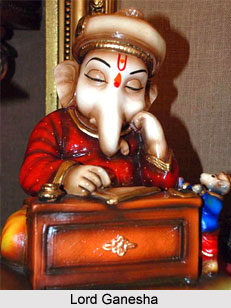 The Legend of Lord Ganesha and Gana is about the precious Chintamani gem of Kapila and the fall of Gana and his forces. Lord Ganesha, also known as Ekadanta, Vinayaka and Gajakarna, is the son of Lord Shiva and Goddess Uma (Parvati) and the elder brother of Lord Skanda (Kartikeya). He is the most renowned Hindu Gods in India and abroad and is regarded as the Remover of Obstacles and. The different Puranas, such as Mudgala Purana, Shiva Purana, Linga Purana, Ganesha Purana, Brahmavaivarta Purana mention various legends of Lord Ganesha related his birth, childhood and marriage. He is described as the god of literature and success and the destroyer of pride and selfishness. Lord Ganesha is also known as Gananayaka, the lord or master of the Ganas. The Ganas were the troop of devotees of Lord Shiva who reside in Mount Kailash with the lord. Ganesha was appointed as their leader by his father Shiva. Once a son was born to King Abhijit and Queen Gunavati; and the parents named the child Gana.
The Legend of Lord Ganesha and Gana is about the precious Chintamani gem of Kapila and the fall of Gana and his forces. Lord Ganesha, also known as Ekadanta, Vinayaka and Gajakarna, is the son of Lord Shiva and Goddess Uma (Parvati) and the elder brother of Lord Skanda (Kartikeya). He is the most renowned Hindu Gods in India and abroad and is regarded as the Remover of Obstacles and. The different Puranas, such as Mudgala Purana, Shiva Purana, Linga Purana, Ganesha Purana, Brahmavaivarta Purana mention various legends of Lord Ganesha related his birth, childhood and marriage. He is described as the god of literature and success and the destroyer of pride and selfishness. Lord Ganesha is also known as Gananayaka, the lord or master of the Ganas. The Ganas were the troop of devotees of Lord Shiva who reside in Mount Kailash with the lord. Ganesha was appointed as their leader by his father Shiva. Once a son was born to King Abhijit and Queen Gunavati; and the parents named the child Gana.
The child grew up to be rather intelligent and strong. Gana was an ardent devotee of Lord Shiva, the Destroyer, who was very pleased by the devotion of Gana. Thus Lord Shiva granted him several boons. But as a result of this, the ego of Gana increased to a great extent. Once Gana went to visit the ashram of Sage Kapila, who possessed a precious gem called Chintamani. The gem contained wish fulfilling powers and had the ability to present food for numerous people. After Gana found the stone, he became greedy and wanted to own the gem; but Sage Kapila refused to give it to him. This made Gana upset and he took the Chintamani gem by force from Kapila. The sage prayed to Lord Ganesha, the remover of obstacles, to help him.
Ganesha manifested in the dream of Gana and decapitated him. After he woke up, Gana became angry, instead of repenting his sinful deed. Gana gathered his army of Bhutaganas to annihilate Sage Kapila. King Abhijit, his father, tried to prevent him and requested him to return the Chintamani gem back to sage Kapila. But Gana remained adamant and went away with his army.
After Gana and his troop of Bhutaganas reached the ashram of Sage Kapila, he discovered that Lord Ganesha was present there along with his own divine army. A fierce battle ensued between Gana and Ganesha and their forces. In the battle, Ganesha destroyed Gana and eventually returned the Chintamani gem back to Sage Kapila. But the sage returned it back to Lord Ganesha, also known as Ganapati, stating that such a powerful gem would create various problems through out the world. Sage Kapila asked the elephant faced deity to stay in his ashram (presently in Theur near Pune) and thus it was known as Chintamani Vinayaka.




















